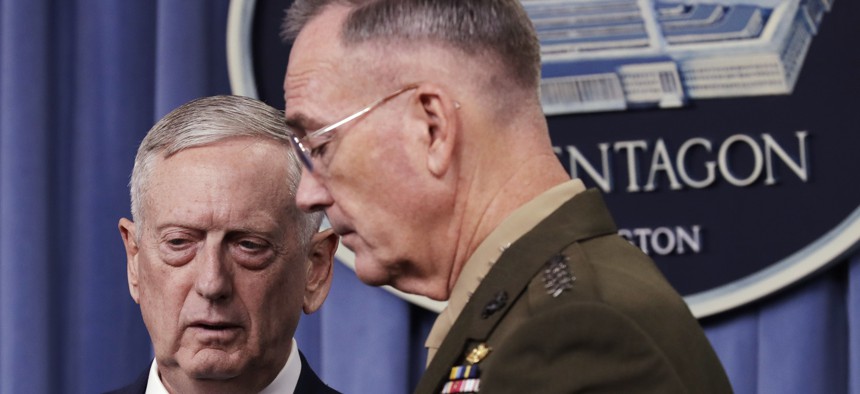
Defense Secretary Jim Mattis and Joint Chiefs Chairman Gen. Joseph Dunford Jr., lay out President Trump's ISIS war plans, at the Pentagon, Friday, May 19, 2017. AP Photo/Jacquelyn Martin
And So It Begins: Trump, Syria, and The Lessons of Iraq
With recent 'warning shot' at Assad, the US is trying to avoid escalation in Syria, not stoke it, sources say.
Pentagon leaders may be talking “annihilation” when it comes to fighting ISIS under the Trump administration, but the reality is that America is focused on limited goals in Syria. The U.S. military is not aiming to take on Syrian President Bashar al-Assad’s forces or their proxies directly any time soon. No one in Washington wants to own the entire Syria crisis after ISIS, and that has not changed from the previous administration to this one.
Rather than seeing last week’s U.S. strike on Assad-affiliated forces as the start of America directly attacking Syria and its proxies, those close to the fight say the response was a warning shot aimed at keeping a tense battlefield from full eruption. It was not a game-changing attack aimed at escalation, sources familiar with the military campaign tell Defense One; instead, it was a way of keeping further escalation from happening.
“That was self-defense of our forces,” said Defense Secretary James Mattis, at last week’s Pentagon’s press briefing. “It was necessitated by offensive movement with offensive capability of what we believe were Iranian-directed – I don't know there were Iranians on the ground, but by Iranian-directed forces inside an established and agreed-upon de-confliction zone.”
In other words, on a small plot of the Syrian battlefield in the nation’s south where U.S. and Russian commanders know where each side has staked out its fight — and the Americans work to keep eyes on all sides — taking on the Assad regime and its allies is not America’s goal. Keeping everyone in their own lane is more like it. Mattis even said the U.S. believes the Russians urged the Iranian-directed forces to stand down but they moved anyway, against Russian wishes.
For all the discussion of escalation in Syria, the military campaign under Trump in Syria is in many ways Obama’s, but faster and with fewer seat belts. Delegation downward of authorities and decision-making abilities may characterize Trump’s relationship with America’s military campaign in Syria, but this administration seems as wary as Obama’s to wade directly and fully into the nation’s civil war. America is ready to help those Syrians left standing —excluding Assad and his regime — once a final peace can be agreed upon. But the White House has not signaled willingness to put U.S. troop’s lives on the line to force who ends up at the peace talks table – at least, not overtly.
Four months into Trump’s administration, U.S. policy toward Syria is as complex as the battlefield itself. America’s limited desire to participate in the fight and the rebuild remain overshadowed by the memory of Iraq and Afghanistan. Military leaders want no exclusive American ownership of the war. Even civilian leaders insist the post-war reconstruction will be different this time around.
“Stabilization is not nation-building,” said Brett McGurk, special presidential envoy for the Global Coalition to Counter the Islamic State of Iraq and the Levant, standing alongside Mattis and Joint Chiefs Chairman Gen. Joseph Dunford at the Pentagon. “Instead, stabilization is a low-cost, sustainable, citizen-driven effort to identify the key projects that are essential to returning people to their homes such as water pumps, electricity nodes, grain silos, and local security structures, local police.”
McGurk continued, “the Raqqa campaign will take time but our core principal holds: after the battle, local people from the area should be in charge of their city and enable to help life to return to the streets and invite people to return.”
McGurk also warned the U.S. won’t do for Syria what it once did for Iraq. Washington won’t pay for Syria’s rebuild.
“The reality in Syria is that until there's a credible political horizon, the international community is not going to come to the aid — particularly the areas under the control of the regime, and these areas have been truly destroyed based upon many of the barbaric tactics that they've used,” McGurk said. “Until we find a political — a credible political horizon, you are not going to see that international support pour in.”
So what should Americans expect next from Trump? When Mattis was asked whether Americans should expect U.S. forces to be in Syria “in some numbers for years to come,” he said that that is “not our intent.” But some level of stability in Syria will be required before withdrawing American forces from further involvement, and to avoid yet another lesson of Iraq by not withdrawing too soon. While local leadership is the ideal, if extremist and extremist-aligned forces want to cause harm to America’s allies, some level of U.S. protection and security and stability will likely be required. (Already, the U.S. is hardening its presence at bases across Iraq.) Ideally, Syrians will find their way to a sustained, durable political solution and locally owned security and governance forces. But until then, and in their absence, someone will have to step up to lend a hand for the long-term, or at the least the medium, lest a security vacuum reappear for ISIS, al-Qaeda, or yet some other extremist group to develop.
